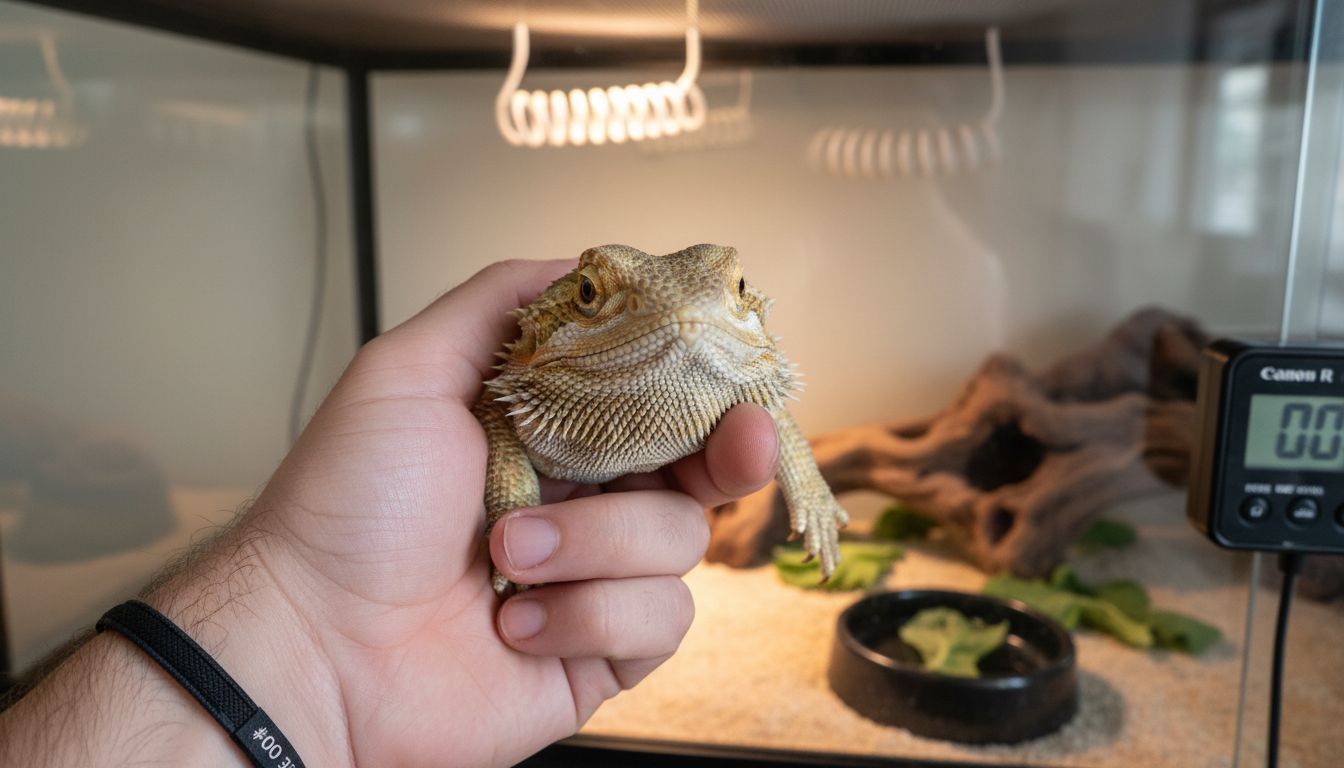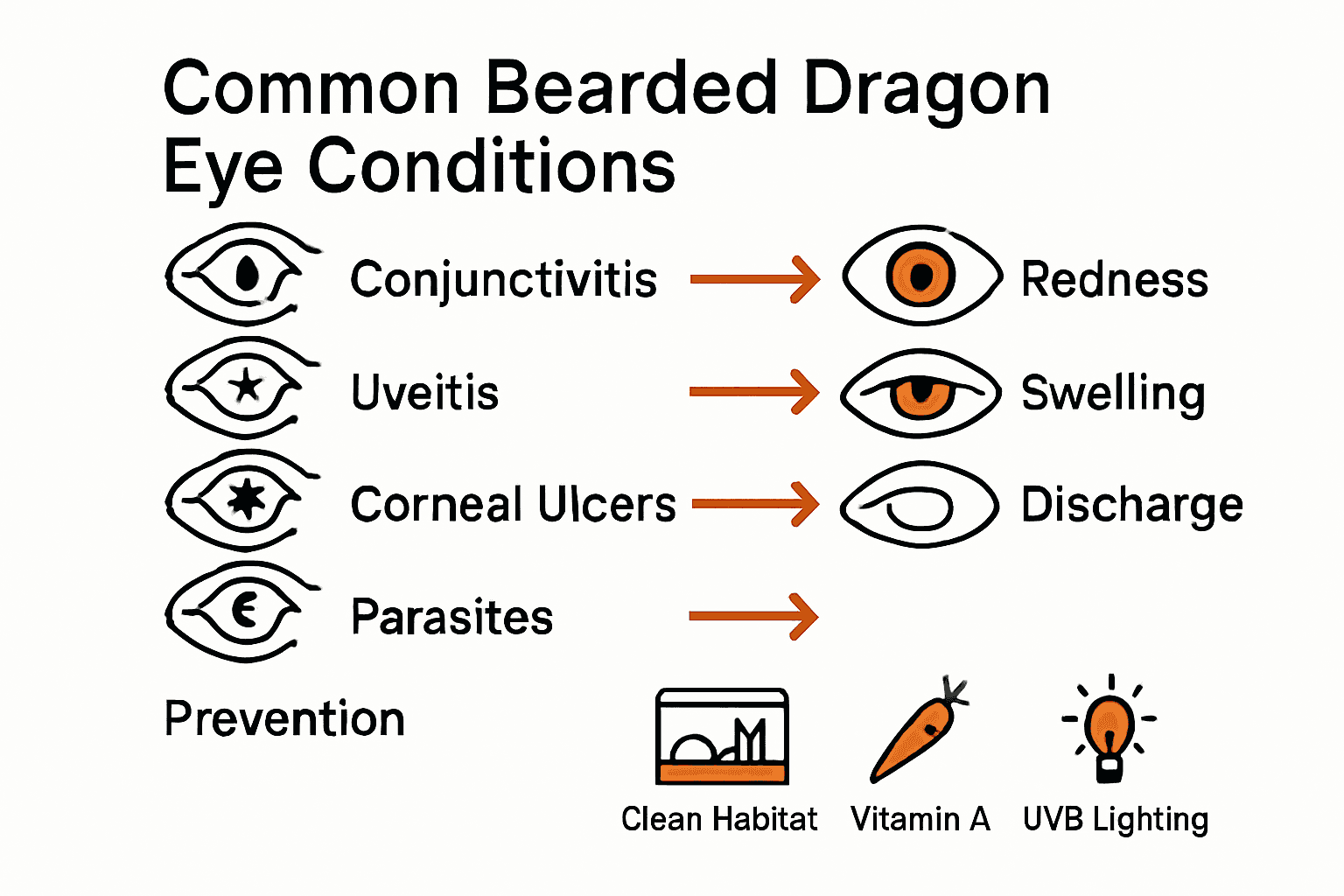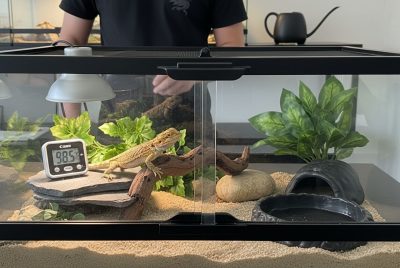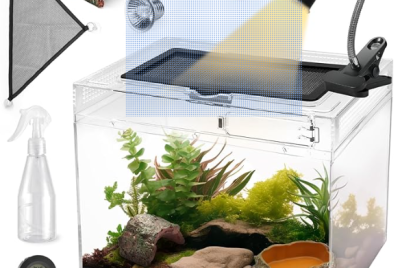Complete Guide to Bearded Dragon Eye Issues
Eye health problems affect nearly one in five american pet bearded dragons, yet many owners miss the early warning signs. Protecting these unique reptiles goes beyond meeting basic needs because their vision is linked closely to their overall well-being. Understanding common eye issues, causes, and proactive care can help owners keep their dragons healthy and comfortable for years to come.
Table of Contents
Key Takeaways
| Point | Details |
| Understanding Eye Health | Bearded dragons can face various eye issues that require early detection to prevent long-term damage. Regular veterinary check-ups are essential for maintaining eye health. |
| Common Eye Conditions | Frequent eye problems include conjunctivitis, corneal injuries, and vitamin A deficiency, which all necessitate specific treatment approaches. |
| Prevention is Key | Maintaining a clean habitat, proper nutrition, and monitoring for early symptoms can significantly reduce the risk of eye complications. |
| Veterinary Care Essentials | Accurate diagnosis and treatment are crucial; consult an experienced exotic veterinarian for comprehensive care of eye issues. |
Understanding Bearded Dragon Eye Issues
Bearded dragons are remarkable reptiles with complex visual systems that can experience a wide range of eye-related health challenges. Their unique eye structure includes not just the standard two eyes, but also a third eye or parietal eye located on top of their head, which plays a critical role in detecting light and regulating circadian rhythms.
Eye issues in bearded dragons can manifest through various symptoms, ranging from subtle changes in appearance to more pronounced behavioral shifts. Common problems include inflammation, discharge, cloudiness, swelling, and unusual eye movements. These symptoms might indicate underlying conditions such as infections, injuries, nutritional deficiencies, or environmental stressors. Recognizing these signs early is crucial for preventing potential long-term vision damage or more serious health complications.

The most frequent eye problems bearded dragon owners encounter include:
-
Conjunctivitis: An inflammatory condition causing redness and discharge
-
Corneal injuries: Scratches or abrasions from rough surfaces or substrate
-
Vitamin A deficiency: Can lead to swollen, infected, or non-responsive eyes
-
Parasitic infections: Microscopic organisms that can impact eye health
-
Metabolic bone disease: Can indirectly affect eye function and overall health
Proper husbandry, regular veterinary check-ups, and a keen understanding of your bearded dragon’s normal eye appearance are essential for maintaining their visual health. For more insights into specific symptoms, check out our guide on bearded dragon symptoms.
Common Types of Eye Conditions in Dragons
Bearded dragons are susceptible to several serious eye conditions that can significantly impact their overall health and quality of life. According to The Pet Enthusiast, these reptiles can suffer from a range of eye-related issues including infections, parasitic infestations, and even eye tumors, each requiring specialized diagnostic and treatment approaches.
Infectious Eye Conditions represent one of the most common challenges for bearded dragon owners. These can manifest through various symptoms such as eye discharge, swelling, redness, and unusual cloudiness. Bacterial and viral infections can quickly escalate if not addressed promptly, potentially leading to more severe complications like corneal damage or systemic health problems.
The most prevalent eye conditions in bearded dragons include:
-
Conjunctivitis: An inflammatory condition causing redness and mucus discharge
-
Uveitis: Inflammation of the inner eye structures
-
Corneal Ulcers: Painful open sores on the eye surface
-
Parasitic Infections: External parasites like mites causing eye irritation
-
Abscess Formation: Localized bacterial infections causing swollen eye areas
Prevention remains the most effective strategy in managing eye health. Maintaining clean habitats, providing proper nutrition, and scheduling regular veterinary check-ups can significantly reduce the risk of these conditions developing. For deeper insights into potential health complications, explore our guide on bearded dragon diseases.

Symptoms and Causes of Eye Problems
Bearded dragon eye problems can emerge from a complex interplay of environmental, nutritional, and physiological factors. While no single cause definitively predicts eye issues, owners must remain vigilant about potential warning signs that might indicate underlying health complications.
Early Detection is critical in managing eye problems. The most common symptoms that dragon owners should watch for include:
-
Discharge: White, yellow, or green fluid around the eyes
-
Swelling: Unusual puffiness or inflammation of eye tissues
-
Cloudiness: Opacity or changes in eye’s normal transparent appearance
-
Squinting: Repeated closing or partial closing of eyes
-
Color Changes: Unusual redness or discoloration of eye tissues
The primary causes of eye problems in bearded dragons typically stem from several key sources. Habitat conditions play a significant role, with improper humidity, inadequate lighting, and unclean enclosures creating environments that stress the reptile’s delicate eye systems. Nutritional deficiencies, particularly vitamin A insufficiency, can compromise eye health by weakening mucous membranes and reducing the dragon’s natural ability to fight infections.
Environmental stressors like incorrect temperature gradients, poor substrate quality, and insufficient UVB lighting can also trigger eye complications. Bacterial and viral infections often exploit these weakened conditions, making consistent habitat management crucial. For more comprehensive insights into maintaining optimal bearded dragon health, explore our guide on bearded dragon third eye care and environmental considerations.
Diagnosis and Veterinary Care Essentials
Diagnosing eye problems in bearded dragons requires a comprehensive approach that combines careful observation, professional veterinary expertise, and specialized diagnostic techniques. Reptile veterinarians with exotic animal experience are crucial in accurately identifying and treating complex eye conditions that can quickly escalate if left unaddressed.
The diagnostic process typically involves several critical steps:
-
Physical Examination: Detailed visual inspection of eye structures
-
Medical History Review: Understanding previous health issues and environmental conditions
-
Microscopic Analysis: Examining eye discharge and tissue samples
-
Blood Work: Checking for underlying systemic health concerns
-
Specialized Imaging: Potential X-rays or ultrasound to assess deeper eye structures
Specialized Veterinary Techniques play a pivotal role in determining the root cause of eye problems. Exotic veterinarians may utilize advanced diagnostic tools like fluorescein staining to detect corneal ulcers, cytology to identify potential infections, and comprehensive blood panels to rule out systemic diseases that might manifest through eye symptoms. Owners should expect a thorough examination that goes beyond surface-level observations.
Prevention and early intervention remain the most effective strategies in managing bearded dragon eye health. Regular check-ups, maintaining optimal habitat conditions, and quick response to any unusual symptoms can significantly reduce the risk of serious complications. For comprehensive guidance on maintaining your dragon’s overall health, explore our guide on bearded dragon diseases to develop a proactive care approach.
Treatment Options and Home Remedies
According to Reptile Craze, treating bearded dragon eye infections requires a multifaceted approach that combines professional veterinary care with strategic home management. While prescription antibiotics often form the cornerstone of medical treatment, owners play a crucial role in supporting their dragon’s recovery through comprehensive care strategies.
Medical Treatments recommended by veterinarians typically include:
-
Topical Antibiotics: Specialized eye drops or ointments
-
Oral Medications: Systemic antibiotics for deeper infections
-
Saline Rinses: Gentle cleaning and inflammation reduction
-
Vitamin Supplements: Boosting immune system response
-
Anti-inflammatory Medications: Reducing eye tissue swelling
Home care represents a critical component of successful eye problem management. Owners should focus on creating an optimal healing environment by maintaining precise temperature and humidity levels, ensuring pristine enclosure hygiene, and minimizing potential stress factors. Soft, clean substrates, reduced handling during recovery, and carefully monitored nutrition can significantly accelerate healing processes.
Prevention remains the most effective treatment strategy. Regular habitat maintenance, balanced nutrition, and immediate attention to any early warning signs can help avoid complicated eye conditions. For additional insights into comprehensive bearded dragon health management, explore our guide on bearded dragon diseases to develop a proactive care approach.
Prevention Strategies for Healthy Eyes
According to Pet Genius Blog, maintaining optimal eye health in bearded dragons requires a proactive, holistic approach that addresses multiple aspects of their environmental and nutritional needs. Preventive strategies are far more effective than reactive treatments, making consistent care crucial for avoiding potential eye complications.
Key Prevention Strategies for maintaining bearded dragon eye health include:
-
Habitat Hygiene: Regular cleaning and disinfection of enclosure
-
Humidity Control: Maintaining appropriate moisture levels
-
Proper Lighting: Ensuring correct UVB and temperature gradients
-
Nutritional Support: Balanced diet rich in vitamin A
-
Stress Reduction: Minimizing environmental disruptions
-
Regular Monitoring: Conducting weekly visual health checks
Nutritional management plays a critical role in preventing eye problems. Dragons require a diet that supports their immune system and promotes tissue health, with particular emphasis on vitamins and minerals that directly impact eye function. Calcium supplementation, balanced protein sources, and fresh vegetables contribute to overall eye health by supporting mucous membrane integrity and reducing inflammation risks.
Environmental factors are equally important in prevention. Owners should create enclosures that mimic natural habitats, with appropriate substrate, hiding spaces, and carefully regulated temperature and humidity levels. For comprehensive guidance on creating the ideal bearded dragon habitat, explore our guide on bearded dragon third eye care and environmental considerations.
Protect Your Bearded Dragon’s Eyes with Expert Care and Resources
Eye problems in bearded dragons can feel overwhelming, especially when you spot symptoms like swelling, discharge, or cloudiness. These issues require prompt attention to prevent lasting damage and keep your pet thriving. Understanding the causes from infections to nutritional deficiencies is just the first step toward effective care.

Take control of your dragon’s eye health today by exploring detailed guides and trusted advice at gobeardeddragon.com. Discover how proper habitat setup, nutrition, and early symptom recognition make all the difference. Start with our bearded dragon symptoms guide and deepen your knowledge with resources on bearded dragon diseases. Visit now to empower your pet care skills and ensure your bearded dragon enjoys clear, healthy vision for years to come.
Frequently Asked Questions
What are the common symptoms of eye problems in bearded dragons?
Common symptoms include discharge from the eyes, unusual swelling or puffiness, cloudiness, squinting, and any color changes in the eye tissues.
How can I prevent eye issues in my bearded dragon?
Prevent eye problems by maintaining habitat hygiene, controlling humidity levels, providing proper lighting, ensuring nutritional support, and minimizing stress factors. Regular health checks are also essential.
What are the main causes of eye problems in bearded dragons?
The primary causes include environmental conditions like improper humidity and lighting, nutritional deficiencies (especially vitamin A insufficiency), and stress in their habitat.
When should I seek veterinary care for my bearded dragon’s eye issue?
Seek veterinary care immediately if you notice significant symptoms such as persistent discharge, swelling, cloudiness, or behavioral changes, as these may indicate serious underlying health conditions.




